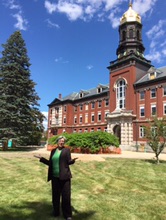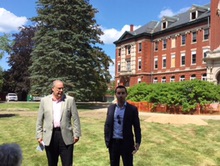Concerned that a number of historic properties in the Portland area are in danger of being irreparably altered or destroyed, Greater Portland Landmarks (Landmarks) recently announced its 4th list of Places in Peril, to call attention to the threats facing character-defining, historically-significant properties in greater Portland. This year, Landmarks has identified seven buildings or areas that are at critical points where they could be permanently lost or diminished.
Landmarks is listing these properties to:
1. Build community awareness about the importance of these properties and focus public attention on their significance in state and local history;
2. Advocate for the preservation, protection, and in some cases, adaptive reuse of these properties so that they can continue to play a vital role in this area’s defining architectural landscape;
3. Provide advice, convene people, and identify resources to preserve, protect and rehabilitate these properties.
The properties include:
1. Portland Motor Sales Building (1963) (currently houses U-Haul), 411 Marginal Way, Portland
Significance: The Portland Motor Sales building is one of Portland’ most well-known Mid-Century Modern buildings, with its iconic folded roof as a character-defining feature of this style. It recently attained “historic” status as it is more than 50 years old.
Threat: The property is vulnerable to redevelopment in an area of rapid regrowth, because this style is typically undervalued and there are no preservation protections for this building or neighborhood.
2. Hay & Peabody’s Seth Thomas Clock (1925), 749 Congress Street, Portland
Significance: The clock is a rare four-dial street clock that has a combination mechanical clockwork and electric motor. It is the only pole-mounted street clock built by the nationally renowned Seth Thomas Co. in the City.
Threat: The clock is in serious disrepair due to a lack of maintenance over the decades. The specialized skills required to fix the clock and its original mechanism, and the associated cost have been barriers to its being restored to working order.
3. Mahoney School (1923-1924), 240 Ocean Street, South Portland
Significance: Eligible for the National Register of Historic Buildings, the Mahoney Middle School is located on a 15-acre lot at the corner of a major transportation route into parts of South Portland and Cape Elizabeth. It was designed by noted Maine architectural firm Miller & Mayo, and is a showcase for the Beaux Arts Style of architecture, preferred for important civic buildings.
Threat: The South Portland School District has received state funding to renovate or replace Mahoney, or consolidate its two middle schools. Depending on the consultant recommendations, the future of the building is at risk. No preservation protections exist on the building to prevent demolition, or to ensure its rehabilitation and guide future additions or changes.
4. Peaks Island Amusement District (1880-1930), Island Avenue, Peaks Island, Portland
Significance: Peaks Island in the late 19th century was famous for is summer entertainment and earned the nickname “Coney Island of Maine.” Greenwood Gardens was a portion of the Peaks Island shoreline transformed into an amusement park.
Threat: Much of the Amusement District has not been formally documented and holds no preservation protections. As the demand grows for higher density and water frontage in the area, significant changes threaten this area’s integrity.
5. Dunn Memorial Church (1906-1907), 4 Brentwood Street, Portland
Significance: The building is an architecturally significant structure and well-known visual landmark on Stevens Avenue, and was determined eligible for the National Register of Historic Places. It is one of the few buildings in Portland designed by noted Bangor architect Victor Hodgins.
Threat: Improper use of mortar has led to decades of structural problems. The building faces extensive damage and an estimated $1.5 million to repair the bell tower. Concern for safety of passing pedestrians led the church to install a fence to keep people away from the stone tower.
6. 19th Century African American Historic Resources on Portland’s Peninsula
Significance: Few historic resources and buildings tell the story of the small but thriving community of African American citizens in 19th century Portland that contributed to its robust history. Three areas in particular, including Newbury Street, Lafayette Street, and the St. John-Valley Street neighborhood, contain buildings that historically represent this story.
Threat: Land values are so high that these neighborhoods are experiencing intense redevelopment, including teardowns for new construction. Most have not been researched and are not within existing historic districts, with the exception of the Abyssinian Meetinghouse, a locally-designated landmark. Therefore, no historic protections exist for these buildings, many of which are modest in size and detail.
7. Bowery Beach School (1855, altered 1985), 11 Wheeler Road, Cape Elizabeth
Significance: One of the last remaining schoolhouses that characterizes the one-room schoolhouses in the Cape Elizabeth/Portland region. Unlike others, this building has been located on its original site since construction and contains most of its original features and architecture.
Threat: A structural assessment shows the building’s framing needs repair from rot and rodent activity, and the current owner’s lack of funding threatens their ability to maintain the structure, putting it at risk.
Landmarks will continue to monitor the endangered properties in hopes that they can be removed from the list in the near future. Landmarks’ intention is to proactively work with property owners as much as possible to protect the properties for the future.





















